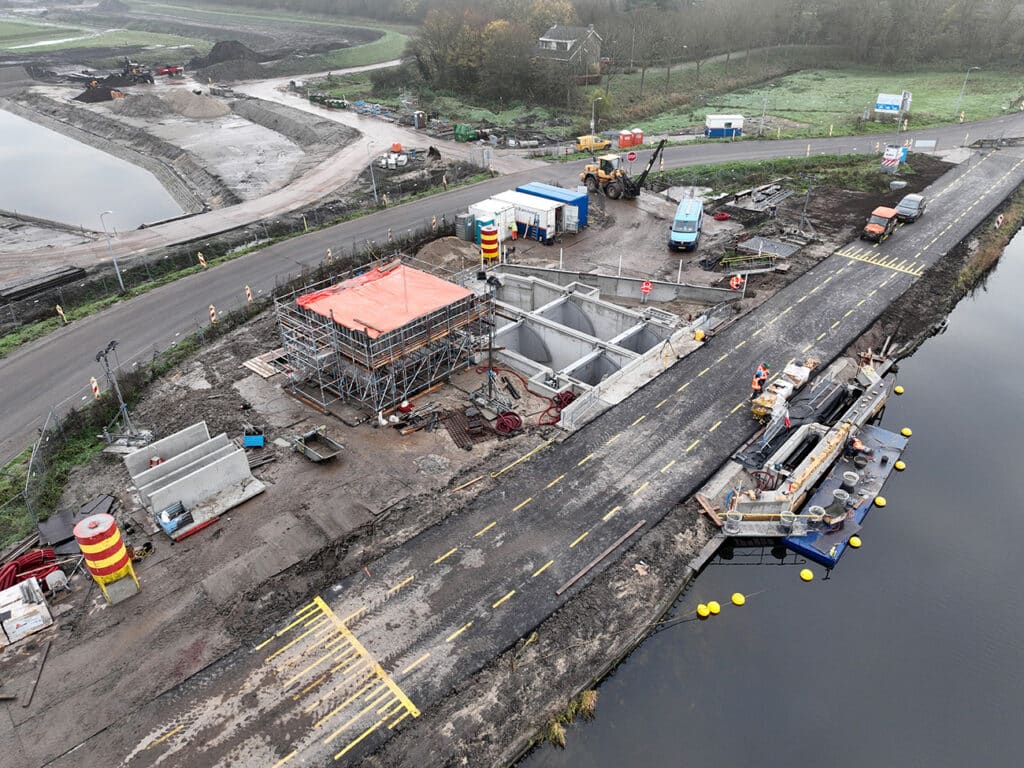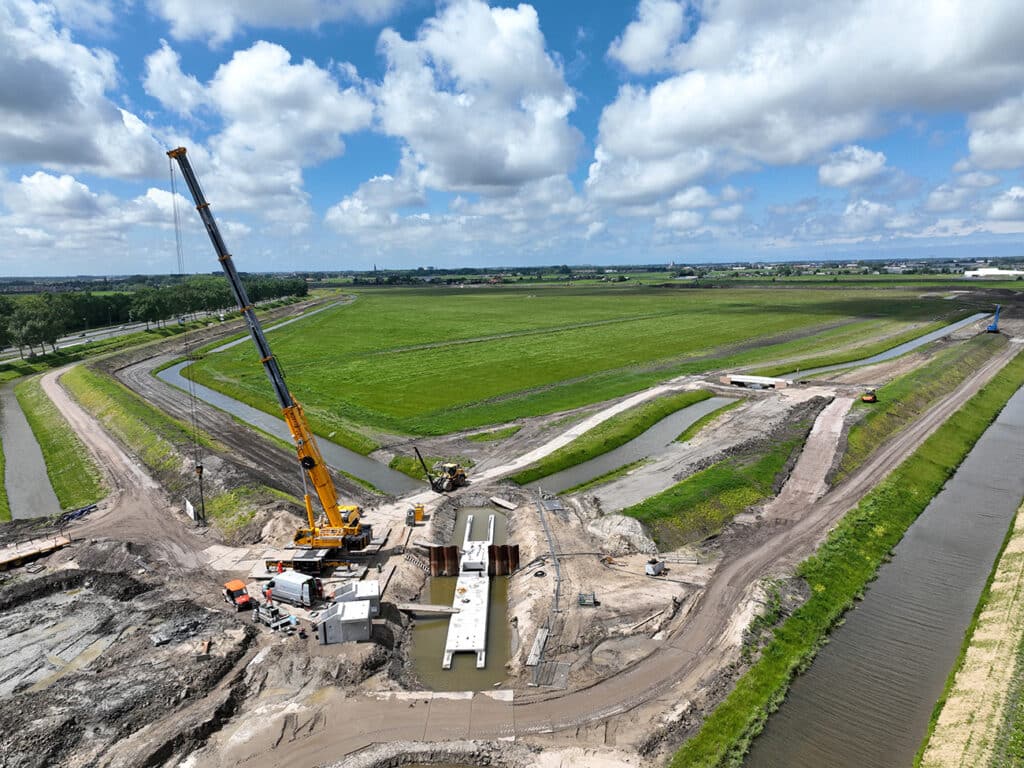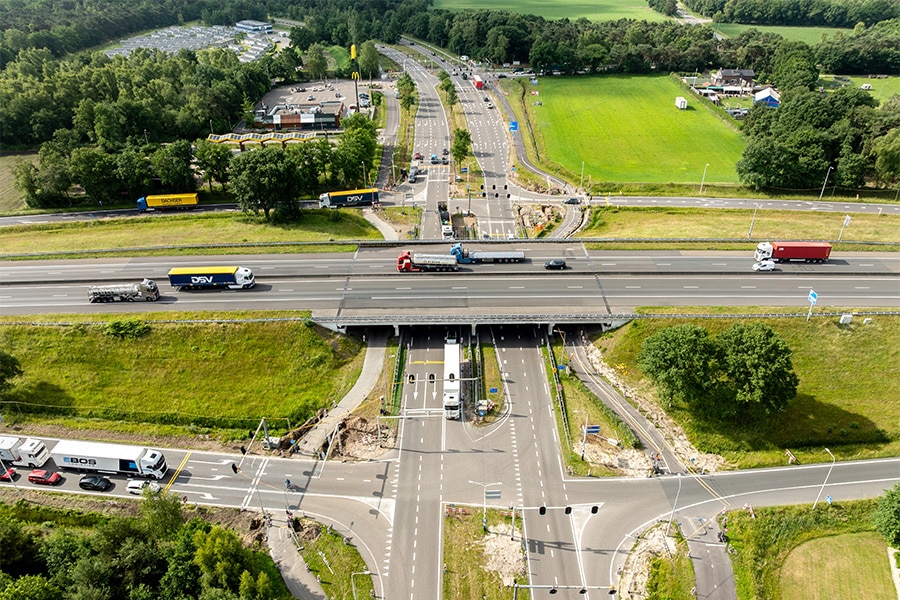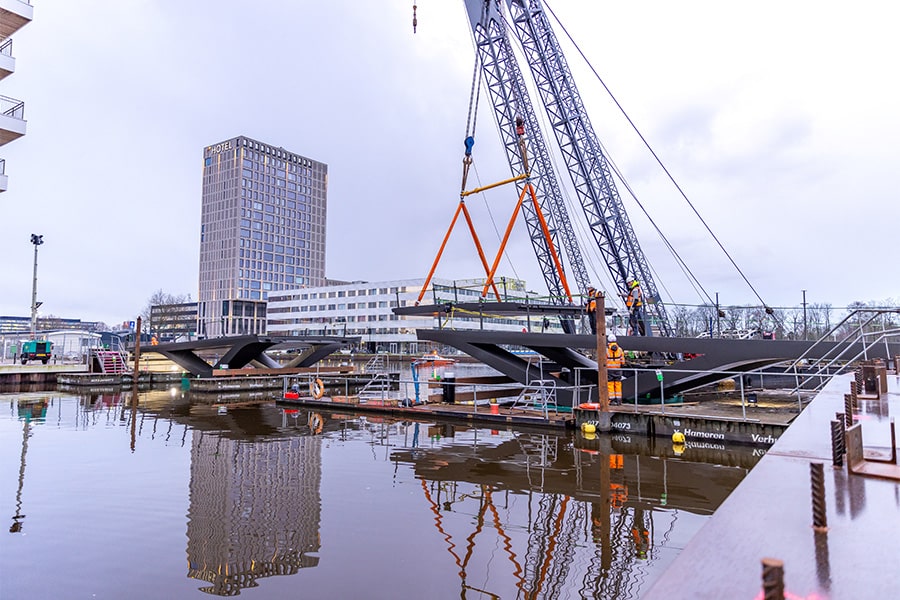
Peak storage Haarlemmermeer
Technical and hydraulic tour de force
The central part of the Rhineland area is at risk of flooding. In order to relieve the four Rhineland storage pumping stations during extreme and prolonged rainfall, a peak storage facility is being constructed in the extreme (and lowest) tip of the Haarlemmermeerpolder to temporarily store 1 million cubic meters of water. Combination KWS - Van Hattum en Blankevoort is carrying out the work on behalf of Hoogheemraadschap van Rijnland. At first glance it may seem a relatively simple project, but there is secretly a lot of functionality in it.

The purpose of Peak Storage Haarlemmermeer is to store excess water from the Ringvaart canal once every fifteen years on average, to prevent waterways from overflowing or worse, embankments from collapsing due to excessive water levels. The idea is to buffer the water for a maximum of ten days, after which the storage area empties in a controlled manner and the water is pumped away by the storage basin pumping stations. "The Rijnland Water Board has prepared the project extremely intensively," begins Frank Boere, design manager on behalf of the combination. "It took more than a decade of work on the plan by various engineering firms to find the perfect system concept and suitable location." That has everything to do with its location in the Haarlemmermeer, adds René Jongejans, project manager on behalf of the combination. "It is a very vulnerable polder given the depth and groundwater issues."

Low dike, large area
So the system concept and location were fixed, Boere continued. "However, it was still a high-over plan that had to be worked out in terms of content. Because peak storage is only expected to be deployed once every 15 years, you want to minimize its impact in daily use. Therefore, a relatively low dike of 2 meters high was chosen, but a large area of ground level (67 hectares). Except for some minor 'obstacles,' there are no restrictions to be able to use the pastures in the peak storage area for arable and livestock farming." The location of the peak repository was carefully chosen. The average ground level is 4 meters below NAP, while the water level of the Ringvaart canal is 0.5 meters below NAP. "This makes it relatively easy for the water to drain into the peak storage area under natural decay via an intake structure. The polder level, the level of the ditches, is 6 meters below NAP, which means that the water from the peak storage can also very easily drain again via outlet channels into the polder ditches from where the pumping stations pump it away," Boere clarified.
Critical soil conditions
The work for the peak storage facility includes the installation of a 3.8 kilometer dike as a "meander" across the ground level with a scour and maintenance path on either side. In addition, the combination will construct approximately 7 kilometers of waterways, build various inlet, outlet and culvert structures, one traffic bridge and five agricultural bridges. The design explicitly takes into account the complexity and limitations of the soil conditions. "The Haarlemmermeer may have been reclaimed, but deep underground there are still aquifers connected to the sea," Boere explains. "If you remove too much soil, there is leakage of saltwater upward with all the consequences that entails." Jongejans: "That is also the reason why we hardly went into the depths, only when constructing the inlet construction and the vole bowl, but these were excavated underwater and provided with an underwater concrete construction. By the way, this construction has a dual function: on the one hand to paralyze the pressure from the subsoil and on the other hand to ensure that no leaching takes place due to the inflowing water."

Sophisticated inlet design
The inlet structure with maelstrom is a technical and hydraulic marvel. "The vole bowl breaks the force of the water that is flowing by 15 m3 per second flows through the inlet structure via the tilting weirs, so that the peak storage area fills up in a dosed manner," Boere explains. "Normally an inlet construction of this kind is constructed completely open or closed; here a combination of the two was chosen. Above the overturning weirs, gratings have been installed to monitor the process, while the intake chute itself is closed and has been placed underground because of landscape requirements. A great deal of attention was paid to the design of the chute construction to eliminate the risk of a vacuum. For example, a 'corner' has been included in the construction behind the weirs to be able to enclose sufficient air and, if that does not turn out well, there is also the possibility of additional aeration in the tube. A back-up facility that we do not expect to need. In addition, a sill has been made at the end of the chute, so that a wave motion is created and the water loses speed towards the voiding bowl."

The crux in the design and realization of peak storage, according to Jongejans, is setting up, managing and controlling a process with the right people in the right place. "It is the essence of such a complex project. That complexity has everything to do with the risk of bursting. So the whole project is worked out in 3D, using the 3D model as input for controlling the machines. And if we unexpectedly encounter weak soil during execution, we go back to the drawing board to properly manage the bursting risks." Incidentally, the project is technically almost complete. "We are going to make the completion date of May 1, 2023 without any problems. Then the grasses will have time to grow and root through and we will test and fill the peak storage in December 2023. Then we should see if the hydraulic concept is actually correct and the peak storage is functioning as planned. We have every confidence in that. We are looking forward to it," concludes Jongejans.
Heeft u vragen over dit artikel, project of product?
Neem dan rechtstreeks contact op met KWS.
 Contact opnemen
Contact opnemen



